Prev Page--Previous Usage || Next Page--Summary and Conclusions
Stratigraphy of the Red Eagle Formation
Red Eagle Limestone
Definition
Heald (1916, p. 24-25) named the Red Eagle limestone and designated the excellent exposures near Red Eagle school, southwest of Foraker, Oklahoma, as the type locality. He described the limestone as consisting of "a number of distinct beds of limestone, between which are beds of shale in some localities. One of the most distinctive features of the top bed of the limestone in much of the [Foraker] quadrangle is the character of the fresh surface, which shows an abundance of tiny grains of crystalline calcite, giving the surface the appearance of having been covered with frost or light snow." The thickness in some exposures "is at least 17 feet, but in others it is probably much less."
Description
The Red Eagle limestone in southern Kansas, as in northern Oklahoma, is a nearly solid limestone section ranging from about 15 to 22 feet in thickness.
Northward from a point in southwestern Greenwood County to southern Nebraska, the formation becomes shaly and contains roughly equal percentages of shale and limestone, except in a bioherm or reef along the Lyon-Wabaunsee County boundary. Except in this bioherm, where the formation is at least 32 feet thick, it ranges from about 10 to 19 feet (cross section, (Pl. 1). The bioherm in the Red Eagle limestone is elongate in a north-northeast to south-southwest direction, has a length of approximately 5 or 6 miles, and is approximately one-eighth to 1 mile wide. The lower part is hard, massive, cherty dolomite and contains a large percentage of voids. The core exhibits a variety of textures and lithologies and parts of it contain abundant fossil remains.
Plate 1. Photomicrographs of thin sections of Red Eagle limestone samples [(magnification x7 1/2 in original text; presented at approx. x30 on web version to show on screen more of what is presented in book]). A and B, Porous, shaly, and dolomitic Howe limestone (Nebraska and northern Kansas facies); C, D, and F, fossiliferous Howe spergenite (central and southern Kansas, northern Oklahoma facies); E, algal Howe limestone with entrapped ostracodes, gastropods, and foraminifers; G, coarsely crystalline limestone in the Bennett shale, chiefly crinoidal but containing bryozoans, algae, foraminifers, and other fossil detritus; H, limestone in the Bennett which contains abundant algal material but includes also bryozoans, brachiopods, and ostracodes; I, abundant fragments of Orbiculoidea in basal part of limestone in the Bennett shale; J, fusulinid-bearing limestone in the lower Bennett shale above Orbiculoidea zone; K, basal 0.6 foot of the limestone in the Bennett member with abundant Orbiculoidea, fragments and fusulinids; L, limestone in the upper part of the Bennett member, contains echinoderm fragments, fusulinids, gastropods, encrusting algae, ostracodes, and foraminifers; M, nonfusulinid Glenrock limestone with abundant foraminifers, ostracodes, gastropods, algae, and shell detritus; N and O, fusulinid-bearing Glenrock limestone with foraminifers, brachiopods, gastropods, bryozoans, and ostracodes. Numbers on the sections correspond to numbers on the detailed sections.
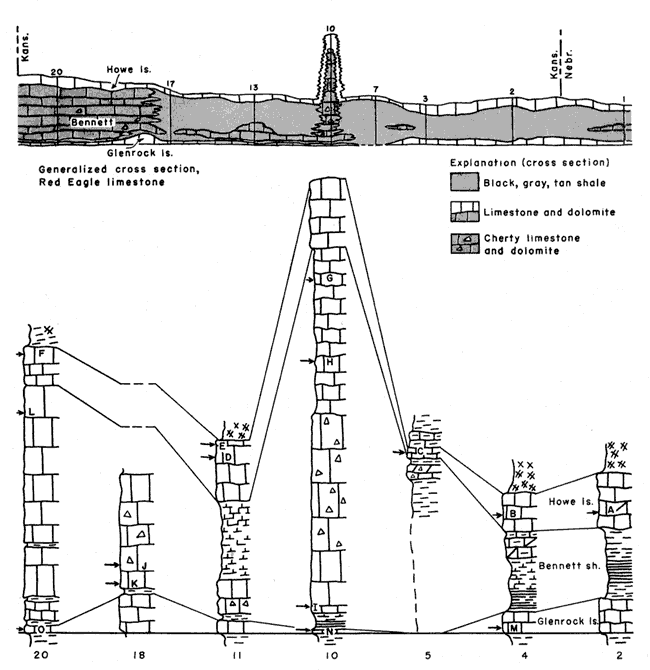
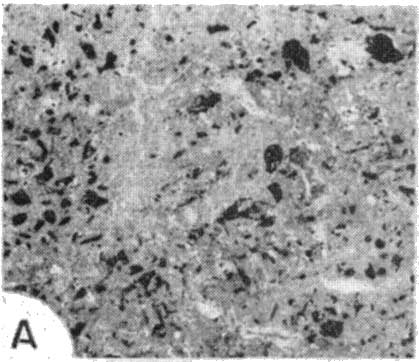
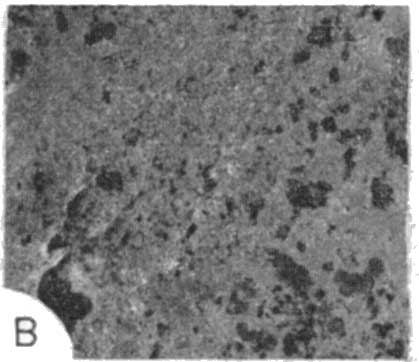
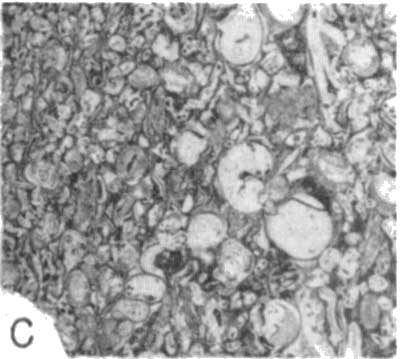
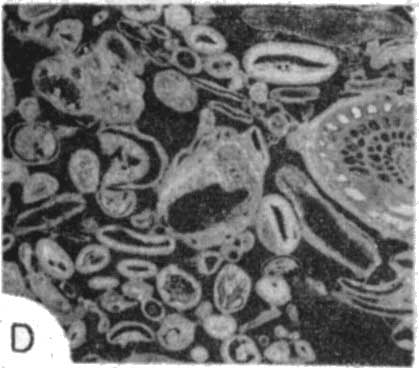
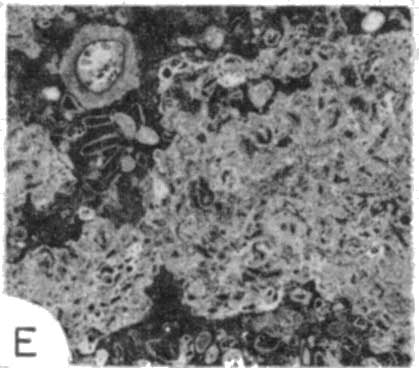
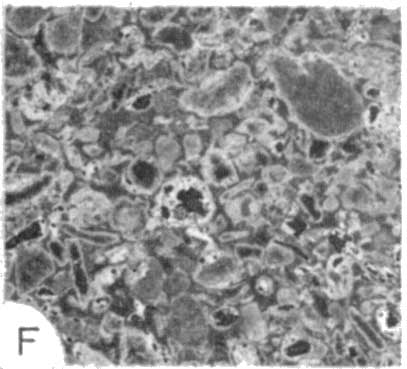
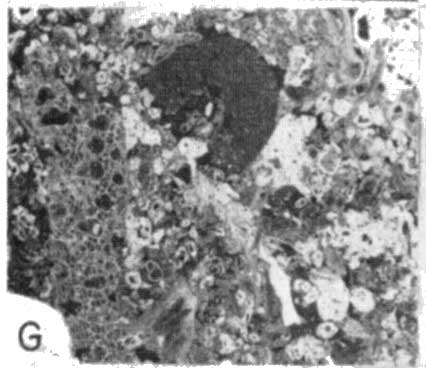
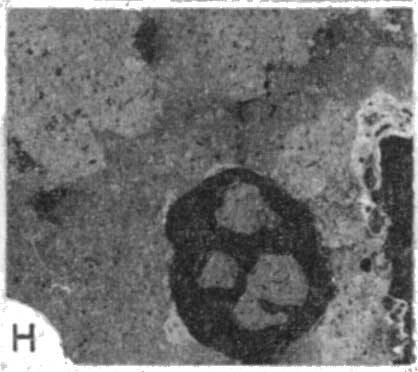
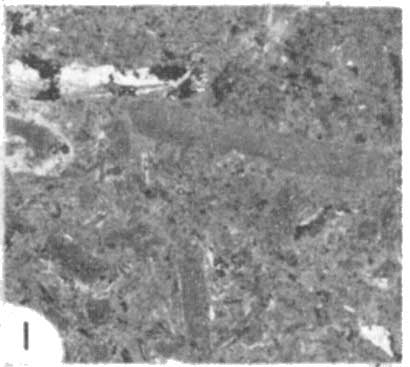
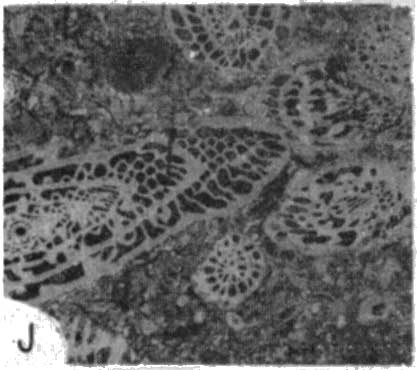
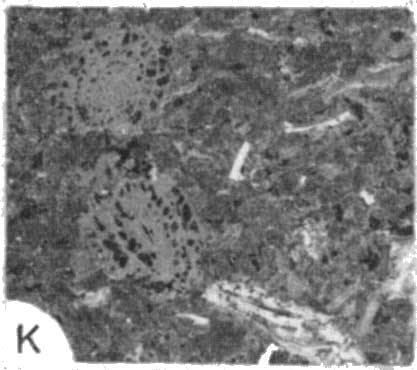
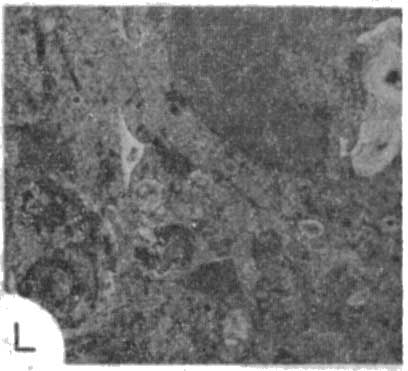
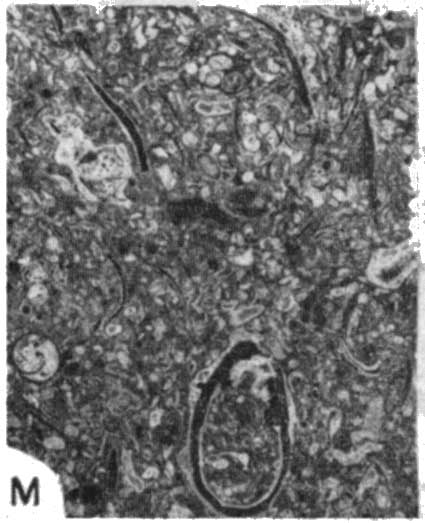
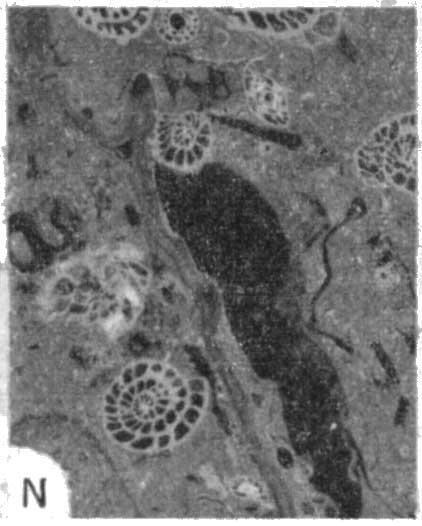
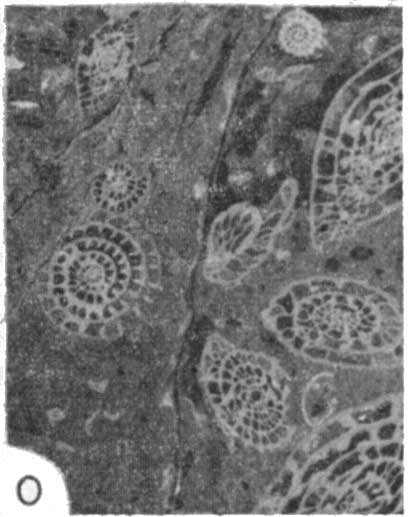
Howe Limestone Member
Definition
Condra (1927, p. 86) defined the Howe limestone as
...named from exposures south of Howe, Nebraska; stone in its unweathered condition, dark gray, massive, and dense, with considerable free calcite; weathers buff to yellowish, granular, vesicular or cavernous, and very irregular; thickness about 4 feet. This carries geodes at places. It has few fossils.
Description
The Howe limestone in southern Nebraska and northern Kansas is essentially as described by Condra. It ranges from about 1 to 4.5 feet in thickness and is characterized by its yellow to buff weathered color and its spongy, vesicular, cavernous, or granular appearance. Secondary calcite, celestite, and quartz occur as scattered crystals or in geodes in the limestone at many exposures. At Bennet, Nebraska, and southward as far as Kansas River the Howe is dolomitic; in this rock fossils are poorly preserved and not readily recognizable (Pl. 1 A and B; Fig. 1, secs. 1-7). Gastropods, ostracodes, and calcareous algae are the chief fossils observed but nowhere are they plentiful.
Between Kansas River Valley and Alma, Kansas (Fig. 1), the Howe limestone changes from a dolomitic, cavernous or vesicular limestone with few recognizable fossils to granular, abundantly fossiliferous spergenite. From Alma, Kansas, southward into Oklahoma the bed comprises buff, gray-brown, or light-gray limestone, generally massive and hard, but locally weathering into thin beds 1 to 3 inches thick. Its weathered surface has a granular texture which Heald (1916, pp. 24-25) noted as being distinctive of the top bed of the Red Eagle limestone in northern Oklahoma. Thickness ranges from about 0.7 to 5 feet (Fig. 1, secs. 7-20). Its maximum thickness is observed in the vicinity of the Lyon-Wabaunsee County line where the Red Eagle limestone develops into a bioherm.
The texture of the limestone is the result of unequal weathering rates of the calcareous fossils and the calcite matrix in which they are embedded. Tiny gastropods, ostracodes, fusulinids and other foraminifers, oolites, and various forms of calcareous algae comprise most of the rock, but fragments of brachiopods, echinoids, and bryozoans occur in lesser amounts ((Pl. 1 C, D, E, and F).
This bed is easily separated by faunal and lithologic characters from limestone layers in the Bennett shale, where the Bennett shale is chiefly limestone.
Bennett Shale Member
Definition
The Bennett shale is described (Condra, 1927, p. 86) as
...named from exposures along the Little Nemaha and its branches south of Bennett, Lancaster County, Nebraska; formed of bluish gray and nearly black argillaceous shale, with one carbonaceous streak resembling coal and a thin yellowish to brownish limestone; combined thickness 5 to 11 feet.
Fauna: Orbiculoidea missouriensis, Lingula sp., Composita subtilita, Spirifer cameratus, and a few other species.
Description
Although much variation in lithology of the Bennett shale is observable along the strike from southern Nebraska to northern Oklahoma, certain faunal zones persist through the lithologic changes and these furnish important evidence for determining member boundaries from north-central Kansas southward.
In the type area, the Bennett shale comprises dolomite and calcareous to argillaceous shale of gray, olive, and tan colors in the upper and middle parts, locally with soft dolomitic shaly limestone near the middle (Fig. 1, sec. 1). This part of the Bennett is characterized by a fauna of calcareous brachiopods, echinoid and crinoid remains, and bryozoans. With minor variations, this faunal assemblage persists entirely across Kansas, although the lithology changes from chiefly shale to chiefly limestone. It constitutes the upper faunal zone of the Bennett shale. The fauna is very unlike that of the Howe, and in areas where the Red Eagle formation is chiefly limestone, as in southern Kansas (Fig. 1, secs. 19-20), the boundary between the Howe limestone and Bennett shale is easily determined.
The lower part of the Bennett shale in the type area comprises black to dark-gray argillaceous shale with local calcareous parts. The brachiopod Orbiculoidea is the most abundant and characteristic fossil but Ambocoelia is also numerous at many exposures. Other fossils are not abundant. The Orbiculoidea-bearing black shale constitutes the lower faunal and lithologic zone of the Bennett shale (Fig. 1, sec. 1). Specimens of Orbiculoidea were found in lower Bennett shale beds in all but 3 of the 18 lower Bennett shale exposures studied (measured sections 7, 13, and 17).
Correlation of the Bennett shale in southern Nebraska and northern Kansas (Fig. 1, secs. 1-6) with the type Bennett presents no difficulty, with one exception. Where the upper part of the Bennett shale contains calcareous or dolomitic shale or shaly limestone (Fig. 1, secs. 2-4), or secondary deposits of calcite and celestite, or chert occur (Fig. 1, secs. 5, 6, 8), the tendency is to include such beds with the Howe limestone. It is our belief, however, that they are equivalent to part of the type Bennett, inasmuch as the fauna included in the beds is typical of the upper Bennett shale, and the calcite and celestite or chert is secondary in the Bennett shale.
The bioherm in the Red Eagle formation near the Lyon-Wabaunsee County line is chiefly the result of Bennett shale expansion (Fig. 1, secs. 9-11). Where the bioherm attains maximum development, about 5 feet of Howe with spergenite lithology is underlain by about 28 feet of Bennett shale. The Bennett comprises about 10 to 12 feet of nonresistant, light-gray, partly coarsely crystalline and partly brecciated limestone containing beautifully preserved large brachiopods, crinoid remains, bryozoans (Pl. 1G), and locally much fine-grained material much of which may be of algal origin (Pl. 1H). Next lower is a resistant massive ledge-making dolomite or dolomitic limestone about 8 to 15 feet thick. It is light gray or tan to nearly white in color, cavernous and porous, and contains scattered nodules of chert. Some exposures of this bed show few or no recognizable fossils but in other outcrops horn corals, fusulinids, crinoids, calcareous algae, and brachiopods are observed. Generally the basal 1 foot or less contains abundant red-brown Orbiculoidea fragments. Tan, gray, and black shale beds, 0.5 to 5 feet thick, parts of which contain abundant Orbiculoidea, occur at the base of the Bennett shale.
From the bioherm southward as far as southwestern Greenwood County, the Bennett shale contains a rather massive, light-gray to nearly white, porous or cavernous, dolomitic limestone in the middle or lower part of the member (Fig. 1, secs. 11-17). Shale above this middle Bennett limestone contains the typical upper Bennett shale fauna, and abundant specimens of Orbiculoidea (Pl. 1, I and K) occur in shale below the limestone (and generally in the lower part of the limestone). The limestone contains chiefly upper Bennett shale fossils.
From a point in southwestern Greenwood County southward into Oklahoma, the Bennett shale becomes nearly a complete limestone section ranging in thickness from about 10 to 18 feet (Fig. 1, secs. 18-20). In this facies of the Bennett member, shale is restricted to one or two thin beds at and near the base of the member and some featheredge partings in the middle or upper part. The basal shale bed and generally the lower foot or less of the limestone beds contain the persistent Orbiculoidea fauna. In some exposures Orbiculoidea shells are abundant and conspicuous; in others they are sparse, so that careful observation is required to find them. Limestone beds of the Bennett are massive, light-gray to buff in color, fine-grained to coarsely crystalline, and fossiliferous. Locally, the beds may be cherty and cavernous but everywhere they are the prominent outcrop-making part of the Red Eagle formation. Fossils are typical of those of the upper faunal zone of the type Bennett, chiefly brachiopods, bryozoans, and echinoderms. In addition, these southern Kansas exposures contain abundant fusulinids, especially in the upper and lower parts. Gastropods, ostracodes, foraminifers, and encrusting calcareous algae are also observed ((Pl. 1, J, K, and L).
Glenrock Limestone Member
Definition
The lower member of the Red Eagle limestone is "named from exposures high in the valleyside just northwest of Glenrock, Nemaha County, Nebraska; dark gray, dense, weathering light gray or slightly buff; thickness 1 to 2 feet. This forms rectangular blocks. The leading fossils are Fusulina, bryozoans, brachiopods, and Pinna sp." (Condra, 1927, p. 86).
Description
The Glenrock limestone can be divided into two faunal and lithologic parts: (1) fusulinid-bearing rock above, and (2) a nonfusulinid part at the base, which may be chiefly algal, foraminiferal, or contain other fossils. The separate parts can best be observed where the Glenrock limestone is a foot or more in thickness. In a few places one or the other is not present or is poorly developed.
Exposures of Glenrock in the vicinity of the type Bennett at Bennet, Nebraska (Fig. 1, sec. 1), include an abundantly fusulinid upper part and a conspicuous algal bed at the base. The algal bed comprises lobate colonies of calcareous algae similar in size and shape to the colonies characteristic of the Houchen Creek limestone member, about 50 feet lower in the section.
At Frankfort, Kansas (Fig. 1, sec. 2), the upper division contains abundant fusulinids and the lower one is a spergenite comprising abundant foraminifers, gastropods, bryozoan and brachiopod fragments, ostracodes, and calcareous algae ((Pl. 1M).
At Manhattan, Kansas, fusulinids could not be identified in one measured section (Fig. 1, sec. 4) but were abundant in another near-by exposure (Fig. 1, sec. 3). Where the fusulinids were absent, brachiopod fragments and small gastropods were the conspicuous fossils, together with rounded sand and gravel size fine-grained limestone detritus. Other fossils were not conspicuous.
From a point between Manhattan and Alma, Kansas, southward to the vicinity of Eskridge, Kansas, the Glenrock limestone is absent, either because of nondeposition or deposition and subsequent erosion in early Bennett time. Where the Glenrock limestone is absent the base of the Red Eagle formation is placed at the contact between the black or dark-gray shale beds and the gray-green or gray limy beds of the Johnson shale (Fig. 1, secs. 5, 7, 8).
The Glenrock reappears in the vicinity of Eskridge and is identified in all the sections studied in central and southern Kansas. South of Eskridge, however, the member is thinner, generally less than 1 foot thick, but ranging from a featheredge to about 3 feet (Fig. 1, secs. 10-20). Fusulinids are observed in most outcrops south of Eskridge but the rock in a few of the exposures studied (Fig. 1, secs. 13, 16) is chiefly algal. In Bennett shale sections containing abundant Orbiculoidea in the lower part, the Glenrock limestone may contain Orbiculoidea fragments in the top crust of the bed. Brachiopods, bryozoans, gastropods, echinoderm fragments, and ostracodes are present also in varying abundance.
Prev Page--Previous Usage || Next Page--Summary and Conclusions
Kansas Geological Survey, Geology
Placed on web July 14, 2006; originally published Dec. 31, 1952.
Comments to webadmin@kgs.ku.edu
The URL for this page is http://www.kgs.ku.edu/Publications/Bulletins/96_8/04_strat.html